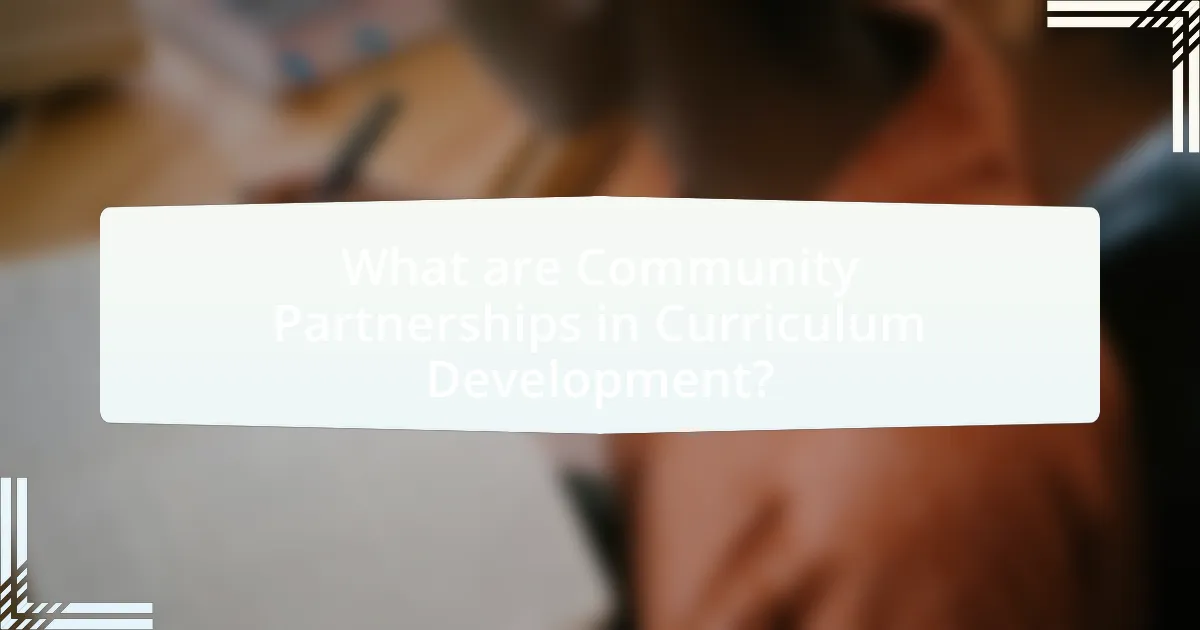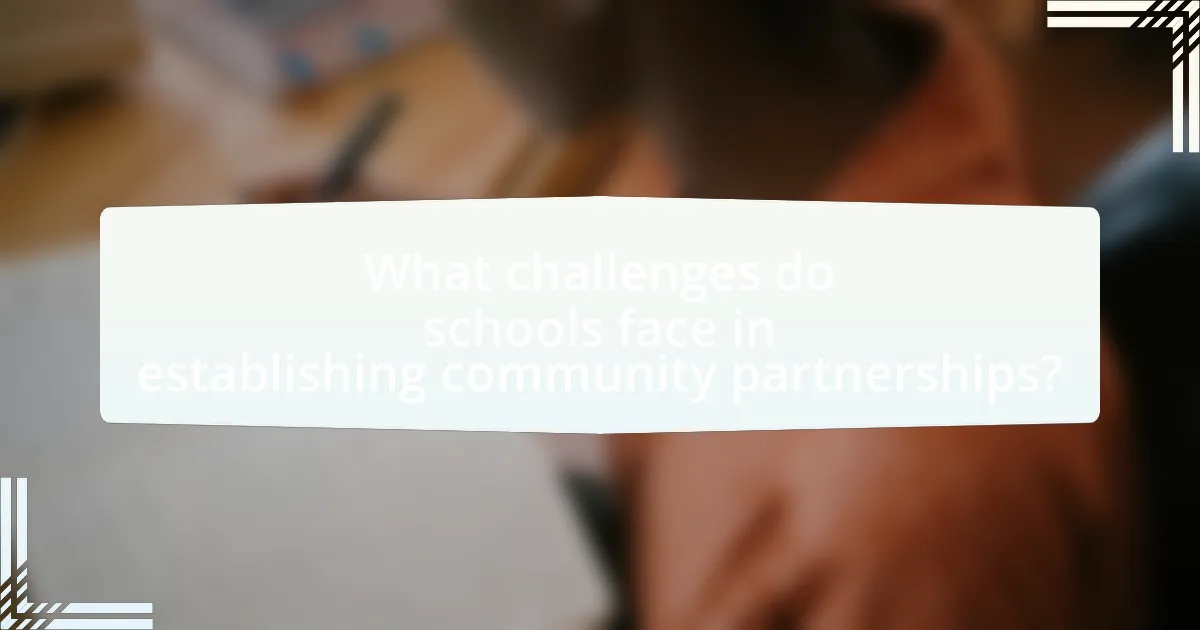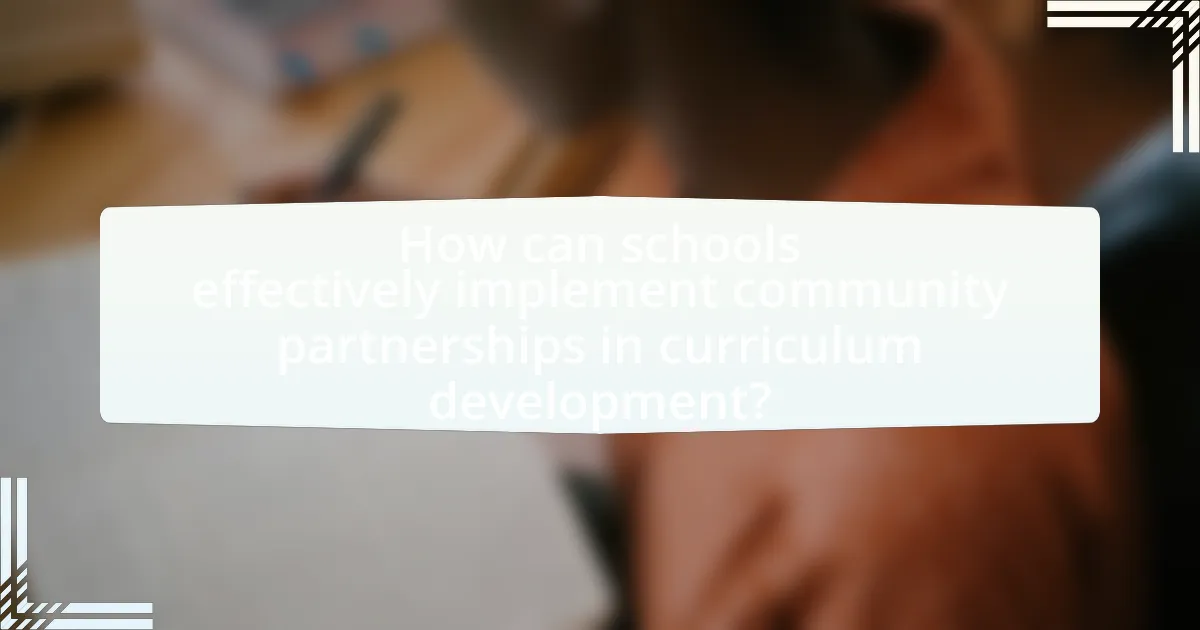Community partnerships in curriculum development are collaborative relationships between educational institutions and local organizations that enhance educational programs by leveraging community resources and expertise. These partnerships significantly influence educational outcomes by improving student engagement, academic achievement, and access to real-world learning experiences. Local organizations contribute to curriculum design by aligning educational content with community needs, fostering a sense of belonging among students. The article explores the roles of community input, the benefits of aligning curriculum with local contexts, challenges schools face in establishing partnerships, and strategies for effective collaboration, ultimately highlighting the essential nature of these partnerships for relevant and impactful education.

What are Community Partnerships in Curriculum Development?
Community partnerships in curriculum development are collaborative relationships between educational institutions and local organizations, businesses, or community groups aimed at enhancing educational programs. These partnerships leverage community resources, expertise, and perspectives to create a curriculum that is relevant and responsive to the needs of students and the local context. Research indicates that such collaborations can lead to improved student engagement and learning outcomes, as they provide real-world applications of academic concepts and foster a sense of belonging and investment in education. For example, a study by the National Education Association highlights that schools with strong community partnerships report higher student achievement and increased parental involvement.
How do community partnerships influence educational outcomes?
Community partnerships significantly enhance educational outcomes by providing resources, expertise, and support that schools may lack. These collaborations often lead to improved student engagement, higher academic achievement, and increased access to extracurricular activities. For instance, a study by the Harvard Family Research Project found that schools with strong community partnerships reported better student performance and attendance rates. Additionally, partnerships with local businesses and organizations can offer mentorship programs and internships, which further enrich the educational experience and prepare students for future careers.
What roles do local organizations play in curriculum design?
Local organizations play a crucial role in curriculum design by providing relevant resources, expertise, and community insights that align educational content with local needs. These organizations contribute to the development of curricula that reflect the cultural, economic, and social contexts of the community, ensuring that education is both applicable and engaging for students. For instance, partnerships with local businesses can offer real-world applications of academic concepts, while non-profits may provide specialized knowledge or support for specific educational initiatives. This collaboration enhances the curriculum’s relevance and effectiveness, ultimately leading to improved student outcomes and community engagement.
How can community input enhance student engagement?
Community input enhances student engagement by aligning educational content with local interests and needs. When students see their community reflected in their curriculum, they are more likely to feel a sense of belonging and relevance, which increases their motivation to participate. Research indicates that schools incorporating community perspectives report higher student attendance and participation rates. For instance, a study by the National Education Association found that schools with strong community partnerships experienced a 20% increase in student engagement metrics. This connection fosters a collaborative learning environment, making education more meaningful and impactful for students.
Why are community partnerships essential for curriculum relevance?
Community partnerships are essential for curriculum relevance because they ensure that educational content aligns with the needs and values of the local community. By collaborating with local organizations, businesses, and stakeholders, educators can incorporate real-world experiences and perspectives into the curriculum, making learning more applicable and engaging for students. Research shows that when schools partner with community entities, such as businesses or cultural organizations, students benefit from enhanced learning opportunities, increased motivation, and improved academic outcomes. For instance, a study by the National Education Association highlights that schools with strong community ties report higher student achievement and greater community support for educational initiatives.
What are the benefits of aligning curriculum with community needs?
Aligning curriculum with community needs enhances educational relevance and improves student engagement. When curricula reflect the specific skills and knowledge required by local industries and cultural contexts, students are more likely to see the value in their education, leading to increased motivation and participation. Research indicates that schools that incorporate community input into their curriculum design report higher student achievement and satisfaction rates. For instance, a study by the National Education Association found that community-engaged curricula can lead to a 20% increase in student performance metrics. This alignment also fosters stronger community ties, as educational institutions become more integrated with local organizations and businesses, creating pathways for internships and job placements that benefit students and the community alike.
How do partnerships foster real-world learning experiences?
Partnerships foster real-world learning experiences by connecting educational institutions with community organizations, businesses, and other stakeholders, thereby providing students with practical applications of their knowledge. These collaborations enable students to engage in hands-on projects, internships, and service-learning opportunities that reflect real-world challenges and scenarios. For instance, a study by the National Education Association highlights that students involved in community-based projects demonstrate improved critical thinking and problem-solving skills, as they apply classroom concepts to actual situations. This integration of community resources into the curriculum not only enhances student engagement but also prepares them for future careers by developing relevant skills and fostering a sense of civic responsibility.

What challenges do schools face in establishing community partnerships?
Schools face several challenges in establishing community partnerships, including lack of resources, differing priorities, and communication barriers. Limited funding often restricts schools from engaging effectively with community organizations, making it difficult to sustain partnerships. Additionally, schools and community entities may have different goals or priorities, leading to misalignment in objectives. Communication barriers, such as differing languages or cultural misunderstandings, can further complicate collaboration efforts. These challenges hinder the potential benefits of community partnerships in enhancing curriculum development and student learning experiences.
How can schools overcome barriers to collaboration?
Schools can overcome barriers to collaboration by fostering open communication and establishing clear goals among all stakeholders. Effective communication ensures that teachers, administrators, parents, and community partners understand their roles and responsibilities, which is essential for collaborative efforts. Research indicates that schools with structured communication strategies, such as regular meetings and feedback loops, experience higher levels of collaboration (Harris & Jones, 2010). Additionally, setting specific, measurable objectives helps align the efforts of various parties, making it easier to work together towards common educational outcomes. By prioritizing these strategies, schools can effectively dismantle obstacles to collaboration and enhance community partnerships in curriculum development.
What strategies can be implemented to build trust with community stakeholders?
To build trust with community stakeholders, organizations should prioritize transparent communication and consistent engagement. Transparent communication involves sharing information openly about goals, processes, and decision-making, which fosters a sense of inclusion and respect among stakeholders. Consistent engagement means regularly involving stakeholders in discussions and activities, ensuring their voices are heard and valued. Research by the National School Boards Association indicates that effective communication and stakeholder involvement lead to increased trust and collaboration in educational settings. By implementing these strategies, organizations can create a foundation of trust that enhances community partnerships in curriculum development.
How can schools effectively communicate the value of partnerships?
Schools can effectively communicate the value of partnerships by showcasing tangible benefits such as enhanced student learning outcomes and increased community engagement. For instance, research from the National Education Association indicates that schools with strong community partnerships report higher student achievement and improved attendance rates. By sharing success stories, data, and testimonials from students, parents, and community members, schools can illustrate how partnerships enrich educational experiences and foster a collaborative environment. Additionally, schools can utilize newsletters, social media, and community events to highlight partnership activities and their positive impact, thereby reinforcing the importance of these collaborations in curriculum development.
What are the potential risks of community partnerships in education?
The potential risks of community partnerships in education include misalignment of goals, resource dependency, and community disengagement. Misalignment occurs when educational institutions and community organizations have differing objectives, which can lead to ineffective collaboration and wasted resources. Resource dependency can arise if schools become overly reliant on community partners for funding or support, potentially jeopardizing their autonomy and sustainability. Additionally, community disengagement may happen if partnerships do not actively involve all stakeholders, leading to a lack of investment and support from the community, which is crucial for the success of educational initiatives. These risks highlight the need for careful planning and clear communication in establishing and maintaining community partnerships in education.
How can schools mitigate conflicts of interest in partnerships?
Schools can mitigate conflicts of interest in partnerships by establishing clear policies and guidelines that define acceptable practices and transparency requirements. These policies should include regular audits and evaluations of partnerships to ensure alignment with educational goals and ethical standards. For instance, implementing a conflict of interest disclosure process allows stakeholders to report potential conflicts, fostering an environment of accountability. Research indicates that schools with structured partnership frameworks experience fewer ethical dilemmas, as seen in a study by the National School Boards Association, which highlights the effectiveness of transparency in maintaining trust and integrity in educational partnerships.
What measures can be taken to ensure equitable involvement from all community members?
To ensure equitable involvement from all community members, implementing inclusive outreach strategies is essential. These strategies can include conducting surveys to identify community needs, hosting public forums to gather diverse perspectives, and providing translation services to accommodate non-English speakers. Research indicates that communities with active engagement processes, such as those outlined in the National Coalition for Dialogue & Deliberation’s guidelines, see higher participation rates and more representative input. Additionally, establishing partnerships with local organizations can help reach underrepresented groups, ensuring that all voices are heard in curriculum development.

How can schools effectively implement community partnerships in curriculum development?
Schools can effectively implement community partnerships in curriculum development by actively engaging local organizations and stakeholders in the planning process. This collaboration allows schools to align educational content with community needs and resources, enhancing relevance and applicability. For instance, research by the National Education Association indicates that schools that partner with local businesses and nonprofits see improved student engagement and academic performance. By incorporating community input, schools can create a curriculum that reflects local culture and prepares students for real-world challenges, thereby fostering a sense of ownership and investment in education among community members.
What best practices should schools follow when forming partnerships?
Schools should establish clear goals and objectives when forming partnerships to ensure alignment with their educational mission. This clarity helps in identifying suitable community partners who can contribute effectively to curriculum development. Additionally, schools should engage in open communication with potential partners, fostering transparency and trust, which are essential for successful collaboration. Research indicates that partnerships built on mutual respect and shared values lead to more impactful educational outcomes. Furthermore, schools should regularly evaluate the partnership’s effectiveness, using feedback to make necessary adjustments and improvements. This practice not only enhances the partnership but also ensures that it continues to meet the evolving needs of students and the community.
How can schools identify and engage potential community partners?
Schools can identify and engage potential community partners by conducting a needs assessment to determine local resources and organizations that align with their educational goals. This process involves mapping community assets, such as businesses, non-profits, and local government entities, which can provide support or resources for curriculum development. For instance, a study by the National Network of Partnership Schools highlights that schools that actively seek partnerships with local organizations can enhance student learning and community involvement. Engaging these partners can be achieved through outreach initiatives, such as hosting community forums or workshops, where schools can present their needs and invite collaboration.
What role does ongoing evaluation play in successful partnerships?
Ongoing evaluation is crucial in successful partnerships as it ensures alignment of goals and fosters continuous improvement. By regularly assessing the effectiveness of collaborative efforts, partners can identify strengths and weaknesses, allowing for timely adjustments to strategies and objectives. Research indicates that partnerships with structured evaluation processes are 30% more likely to achieve their intended outcomes, as they facilitate open communication and accountability among stakeholders. This iterative feedback loop not only enhances trust but also promotes shared learning, ultimately leading to more effective curriculum development in community partnerships.
What resources are available to support community partnerships?
Resources available to support community partnerships include grants, training programs, and collaborative networks. Grants from organizations such as the U.S. Department of Education provide funding for initiatives that foster community engagement in educational settings. Training programs offered by institutions like the National Community Education Association equip stakeholders with skills to build effective partnerships. Collaborative networks, such as the Community Schools Initiative, facilitate connections between schools and local organizations, enhancing resource sharing and support. These resources collectively strengthen community partnerships, which are essential for successful curriculum development.
How can schools access funding for partnership initiatives?
Schools can access funding for partnership initiatives through grants, local government funding, and collaborations with businesses and nonprofits. Various organizations, such as the U.S. Department of Education, offer competitive grants specifically aimed at fostering community partnerships that enhance educational programs. Additionally, local governments often allocate funds for educational initiatives that involve community collaboration, while businesses and nonprofits may provide sponsorships or donations to support specific projects. For example, the 21st Century Community Learning Centers program provides federal funding to support after-school programs that engage community partners, demonstrating a structured approach to securing financial resources for partnership initiatives.
What tools can assist in managing and sustaining partnerships?
Collaboration platforms such as Slack, Microsoft Teams, and Trello can assist in managing and sustaining partnerships. These tools facilitate communication, project management, and task tracking among partners, ensuring that all stakeholders remain engaged and informed. For instance, Slack allows for real-time messaging and file sharing, which enhances collaboration, while Trello provides a visual overview of project progress, making it easier to manage tasks and deadlines. Research indicates that effective communication tools can improve partnership outcomes by up to 30%, highlighting their significance in sustaining collaborative efforts.
What are some practical tips for fostering successful community partnerships?
To foster successful community partnerships, organizations should prioritize clear communication and mutual goals. Establishing open lines of communication ensures that all parties understand each other’s needs and expectations, which is crucial for collaboration. Additionally, aligning objectives helps create a shared vision, making it easier to work together effectively. Research indicates that partnerships with defined goals are 30% more likely to succeed, as they provide a framework for accountability and progress tracking. Engaging community members in the decision-making process also enhances ownership and commitment, further solidifying the partnership’s foundation.

Leave a Reply